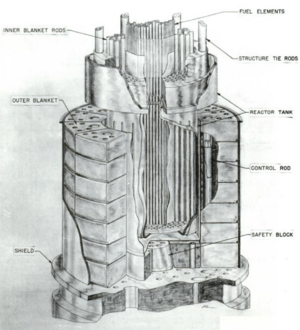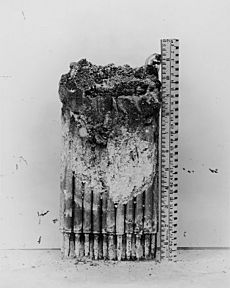Experimental Breeder Reactor I facts for kids
|
Experimental Breeder Reactor No. 1
|
|

Experimental Breeder Reactor Number 1 in Idaho, the first power reactor
|
|
| Location | Butte County, Idaho, US |
|---|---|
| Nearest city | Arco, Idaho |
| Built | 1950 |
| Architect | Atomic Energy Commission |
| NRHP reference No. | 66000307 |
Quick facts for kids Significant dates |
|
| Added to NRHP | October 15, 1966 |
| Designated NHL | December 21, 1965 |
The Experimental Breeder Reactor I (EBR-I) is a special building in the desert near Arco, Idaho. It used to be a research reactor, which is like a mini-power plant for experiments. Today, it's a U.S. National Historic Landmark, meaning it's a very important historical site.
EBR-I made history on December 20, 1951. At 1:50 p.m., it became one of the first places in the world to make electricity from nuclear power. It first lit up four 200-watt light bulbs! Soon after, it made enough electricity to power its own building and even the nearby town of Arco. Scientists used EBR-I for experiments until it was shut down in 1964. Now, it's a museum that visitors can explore from late May to early September.
Contents
How EBR-I Made History
Building EBR-I started in late 1949. A team led by Walter Zinn at the Argonne National Laboratory in Idaho designed and built it. This site is now part of the Idaho National Laboratory.
The reactor began working on August 24, 1951. On December 20 of that year, it made electricity for the very first time. The next day, it produced enough power to light up the entire building. EBR-I created 200 kW of electricity from 1.4 MW of heat.
While EBR-I was the first to make electricity for its own building, another reactor had a small experiment earlier. In September 1948, the X-10 Graphite Reactor in Tennessee used a tiny steam turbine to power a single light bulb.
Later, in 1955, another reactor called BORAX-III powered the entire city of Arco, Idaho. This was the first time a city was powered only by nuclear energy!
What is a Breeder Reactor?
The main goal of EBR-I was not just to make electricity. It was built to test a special idea in nuclear physics. This idea was about creating a "breeder reactor". A breeder reactor can make more nuclear fuel than it uses.
Here's how it works: A reactor uses tiny particles called neutrons. In a breeder reactor, these neutrons can change a material called "fertile material" into new "fissile material." Fissile material is the kind that can be split to release energy.
EBR-I was designed to turn uranium-238 into plutonium. Plutonium is another type of nuclear fuel. Scientists hoped to make more plutonium than the uranium-235 fuel they started with. In 1956, tests showed that EBR-I successfully achieved this goal. This made it the world's first true breeder reactor!
A Small Incident at EBR-I
On November 29, 1955, something unexpected happened at EBR-I. During a test, the reactor had a partial "meltdown." This means some of the fuel got too hot and melted a little. Scientists were trying to understand why the reactor was acting strangely when the coolant flow changed.
After the incident, the reactor was fixed. Further experiments showed that the fuel rods and their supports expanded too much when they got hot. This expansion was causing the unexpected behavior.
EBR-I was important for many reasons. It was one of the first to make electricity from atomic energy. It was also the first breeder reactor. Plus, it was the first to use plutonium fuel to make electricity.
How EBR-I Was Designed
EBR-I used a "seed-and-blanket" design. The "seed" was the core, made of highly enriched uranium. This uranium had a lot of uranium-235, which is the part that splits easily.
Around the core was an "inner blanket" of natural uranium rods. This whole setup was inside a double-walled tank filled with a special liquid metal called NaK. This liquid metal was the primary coolant, meaning it carried away the heat.
Outside this tank was an "outer blanket" of natural uranium. This blanket helped reflect neutrons back into the core, making the reactor more efficient. It also held the control rods, which are used to start and stop the reactor. The outer blanket was air-cooled, which limited how much power the reactor could make. It reached a maximum of 1.4 MW of heat.
How the Cooling System Worked
The liquid metal coolant flowed by gravity from a tank through the reactor core. Here, it absorbed the heat created by the nuclear reactions. Then, this hot coolant went to a heat exchanger. There, it transferred its heat to a secondary coolant, which was another liquid metal.
An electromagnetic pump then sent the primary coolant back to its supply tank. The secondary coolant was pumped to a boiler. In the boiler, it heated water, turning it into steam. This steam then spun a turbine, which is how electricity was made! After spinning the turbine, the steam cooled down and turned back into water, ready to be pumped back to the boiler.
EBR-I's Legacy
Argonne National Laboratory shut down EBR-I in 1964. A new reactor, Experimental Breeder Reactor II, took its place.
EBR-I was named a National Historic Landmark in 1965. A special ceremony was held on August 25, 1966, with President Lyndon Johnson and Glenn T. Seaborg attending. In 2004, it was also recognized as an IEEE Milestone for its important contributions to electrical engineering.
Images for kids
See also
 In Spanish: Experimental Breeder Reactor I EBR-I para niños
In Spanish: Experimental Breeder Reactor I EBR-I para niños
- Obninsk Nuclear Power Plant, the first nuclear reactor to supply electricity to a power grid.
- Calder Hall, England, the first nuclear power station to deliver power in commercial quantities.
- List of National Historic Landmarks in Idaho
- National Register of Historic Places listings in Butte County, Idaho










